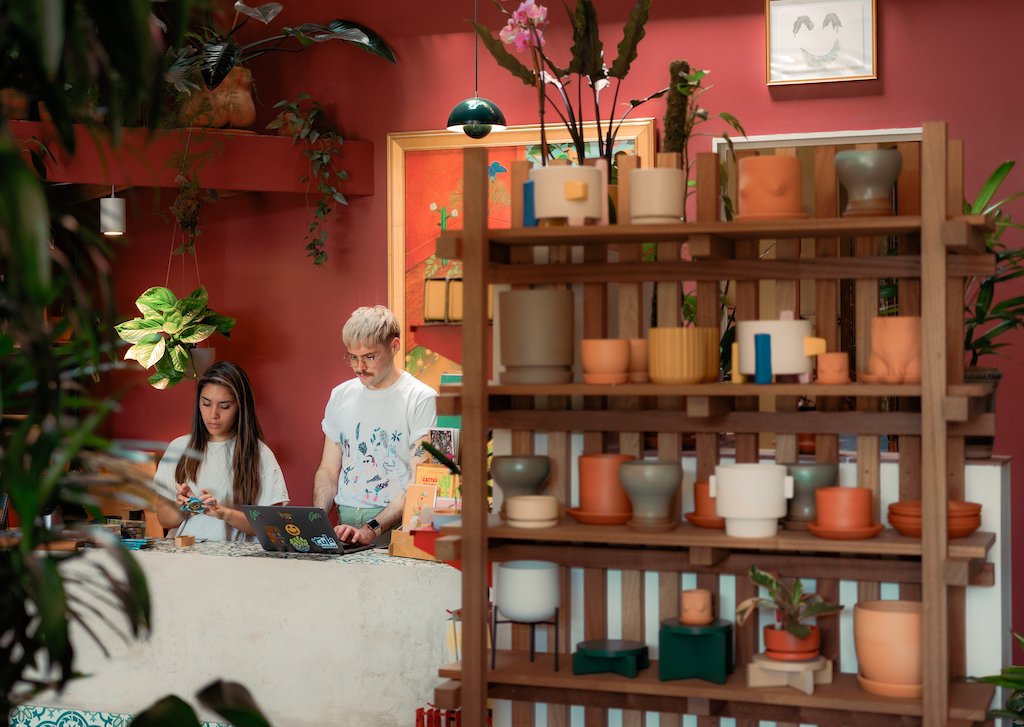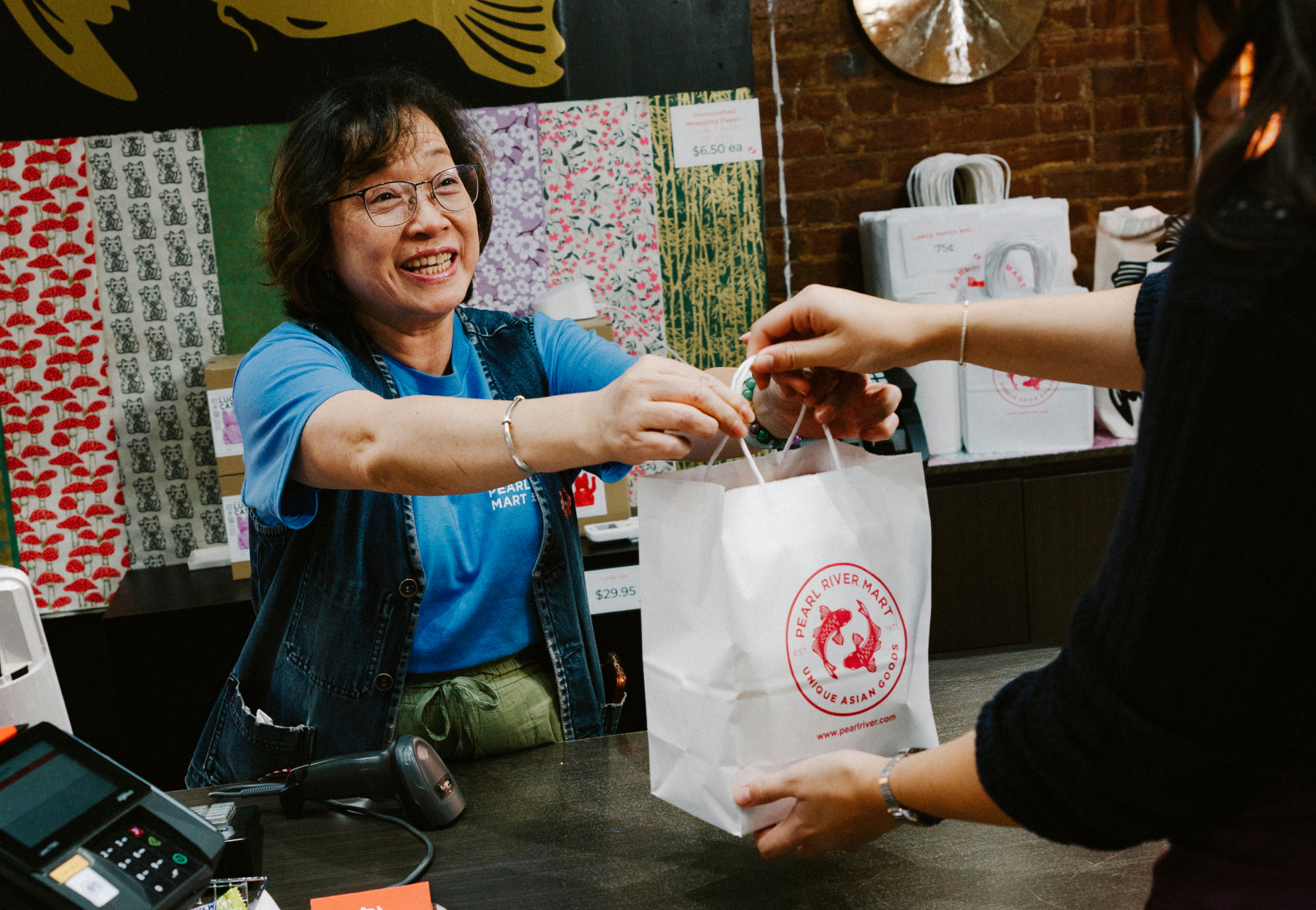

Every entrepreneur starts their business for a reason. Perhaps you want to share something special, make your customers feel a certain way, or offer your curated perspective on better living. At the end of the day, you want customers to feel inspired to buy something. And everything you do to that end – promoting and selling your products – is called merchandising.
No matter where you are on your small business journey, merchandising can be confusing. That’s why we sat down for a chat with Kristin Fisher, a former corporate retailer buyer who is now the CEO of Bocu. She’s also a retail strategy coach for independent creators and shop owners. Below, she shares some of her most valuable guidance on how to execute a powerful merchandising strategy.
Create a visual story around your best products
Merchandising is a lot about editing, Kristin explains. “You’re maximising your investments by telling your customers what they want through your visual displays,” she says. “If you’re not doing any editing and they’re overwhelmed, they won’t buy. Show the products you stand behind, then create your story around them.”
When it comes to both digital and in-person merchandising, Kristin suggests you start with your top five products. “If you begin with the experience you want to create and then try to fit your products into that model, you’ll lose steam,” she explains. “There’s only so much space. Think about your revenue drivers, then build your visual strategy around that.”
This is true in a physical store, when you’re vying for someone’s actual line of sight, and online, where attention spans are simultaneously pulled in a thousand different directions. “Having your profit investment tie back to your visual strategy is key because you’re covering both profit and customer experience,” Kristin says.
One rule that she’s found applies to retailers of all sizes is that 80% of your sales will come from 20% of your products. “Protecting that top 20% and making sure you have those prominently displayed throughout the store is paramount.” To do that, Kristin emphasizes the idea of multiple exposure touchpoints: for example, including your bestselling sweater in various colours and ensembles throughout your store. “You’re selling it in one place, but you’re also subliminally showing it in others, revealing the versatility of each piece.”
Create moments of discovery
We’ve talked a lot about the joy and significance of serendipity in the consumer shopping experience, and Kristin agrees this is crucial in merchandising. “In physical stores, people are craving that personal, engaging experience where there’s connection and community,” she says.
When it comes to providing that opportunity for customers, Kristin emphasizes paying attention to all five senses. “You don’t want just stacks of T-shirts everywhere. Build your story with layered merchandising,” she says. “Burn a candle, add textures and include elements that aren’t even for sale, like water or music.” She suggests using different levels for the eye to follow and thinking through the journey your customer takes in person and online. “You want to create moments that are aesthetically pleasing and speak to the story you’re telling. Make sure there’s breathing room and pockets of space for discovery.”
Of all the trends Kristin has seen come and go, one has true longevity: Consumers shop with their values. As a buyer, you’re likely already looking for brands that espouse your values. Whether it’s in your store or online, every visual choice you make should help a shopper connect their values to yours. This could be through signage, a QR code or a path through your store that highlights relevant brands. “Creating this avenue for your customers to identify with your values (and shop their own) builds trust – and keeps them coming back for more.”
Create moments that are aesthetically pleasing and speak to the story you’re telling. Make sure there’s breathing room and pockets of space for discovery.
Kristin Fisher, retail strategy coach
Think beyond your current season
Kristin often sees a lot of independent retailers struggling with too many options, a surplus of one product or both. “We often buy from emotion without a forecasting plan in place, instead of thinking about the long-term plan and what might carry over,” she says. This can quickly become a problem when, say, it’s fall and you still have too much inventory from spring. The most beautiful merchandising plan won’t execute if you’re combining too many different concepts.
Instead, Kristin suggests, “think like a buyer.” Consider what will happen if you’re left with one product or another and how you’ll pivot to accommodate. Make sure your bigger investments are versatile and can be shown in different ways in your merchandising and marketing, then show your customers multiple ways to use or wear them. “If you’re left with too much of a ‘holiday red’ item, for example, you could repurpose it into a mini Valentine’s Day capsule, or hold the inventory for the next season and reshoot it-slash-style it in a way that feels ‘new’ to your customer,” Kristin says.
Trust the numbers and stay flexible
To track and assess the success of your merchandising strategy, know your numbers. “Look at your data, how many units you’re selling, and your sales reports,” she says. Use Faire, Excel spreadsheets, or Shopify to get organized, then keep checking in. Pull different levers, move things around, and see what happens. Experiment if sales are slow. Discount or promote one item for a weekend when you know you’ll have high foot traffic (or it’s a busy day of the week online).
Though it’s tempting to insist a product will eventually do well even when the numbers say it’s definitely not, remember: “Your numbers don’t lie,” says Kristin. “Being willing to change the plan after assessing the data is crucial. And don’t just look at your sales units. Compare them to your inventory units.” This can be especially true during the holidays. “So many retailers and small business owners are afraid to promote early in December,” she says. “But if you have a lot of inventory, don’t wait until December 20 to do the promo.”
Feeling stuck? Start with these three steps
For retailers doing a merchandising refresh, or just getting started, here’s Kristin’s quick-start strategy:
- Know what you have: “Get clear on what you have on hand before you move forward,” she says. Do you have items you need to run through a promotion to get moving? Can you use what you have and show it differently? Can it be pulled off the floor and shown later?
- Know where you’re going: “Have a point of view before you start buying and be clear on your budget.” What is your story for this collection? This could be a colour, a theme like women-owned, a celebration of the season, etc.
- Know your customer: “Think about your customer experience. Look at the space that you have and step back and look at it with a bird’s-eye view. How can you create that experience for your customer?”
In short: Think about where you are, where you want to go, and what you can afford to do—then take action.




